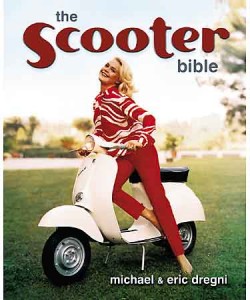The Scooter Bible, compiled by brothers Michael and Eric Dregni, is a superbly readable, and viewable, tome on the history of motorscooters. Most Americans think of scooters as some mildly bizarre sub-species of the motorcycle world, but in truth they inhabit a universe of their own.
The Dregni boys apparently know more about these contraptions than does most of the rest of America combined, and they have made good use of their arcane knowledge by putting together a great many excellent pictures with an entertaining text and a whole lot of humorous captions in this “publication that is preeminent especially in authoritativeness”—which is a Merriam-Webster’s definition of the word “bible.” Nothing blasphemous going on here, merely a compilation of scooter lore.
To qualify as a scooter the motorized two-wheeler must have small wheels and a step-through chassis design…although, of course, there are numerous exceptions. This concept began life as an inexpensive way to get from hither to yon, often based on what looked like a child’s push scooter with a tiny motor attached, such as the 1914 Autoped. Rake and trail were not part of the specifications.

The first minor boom in scooters was in the 1930s, when roads were getting better, traffic heavier, and the Great Depression meant there was little money available. The Salsbury and Cushman and a dozen other U.S. makes competed for the American dollar back then.
It was following World War II that scooter sales really took off, based on war-ravaged Europe’s desire to get mobile—with Italy’s Vespa and Lambretta leading the way. Here was cheap, fuel-efficient transportation, which even had its own spare wheel in case of a flat. Italian commuters loved them, and that country’s generally good weather probably had something to do with this. Scooters also flourished seasonally in more northern climes, like Germany and Britain. But in the United States, with inexpensive gas and more money, the Chevrolet Stylelines and Nash Ramblers won out—except for the newsboys lusting after Mustang Colts and Briggs & Stratton-powered Doodle Bugs. In 1951 Sears & Roebuck bought the rights to rebadge the Cushman Pacemaker as an Allstate Deluxe and sold it through the mail for $219.95. What a deal!
In the late 1950s several motorcycle manufacturers tried to cash in on the scooter market, with Harley marketing the Topper, Triumph the Tigress, but the marketing types had hopelessly misread the market. Scooters were on the way out, with big-wheel bikes like Honda’s Cub and Yamaha’s Riverside becoming the mini-transporters of choice. By 1970 there was hardly a scooter to be found on any showroom floor.
Now we have a resurgence in scootering. Vespa has reappeared in U.S. showrooms, sold more as a fashion accessory than a useful commuter. Three of the Japanese Big Four companies are offering the Americans better than a dozen different models for 2006, everything from a Yamaha 50cc Vino to a 650cc Suzuki Burgman, while other Asian manufacturers, notably Chinese, are set to flood the market. With traffic and parking getting nothing but worse, and the price of gas skyrocketing, this may become the urban transport of the next decade. That would be nice.







